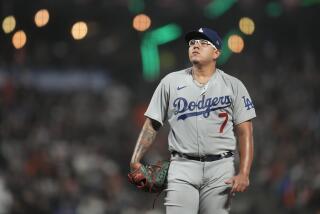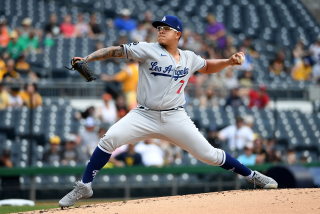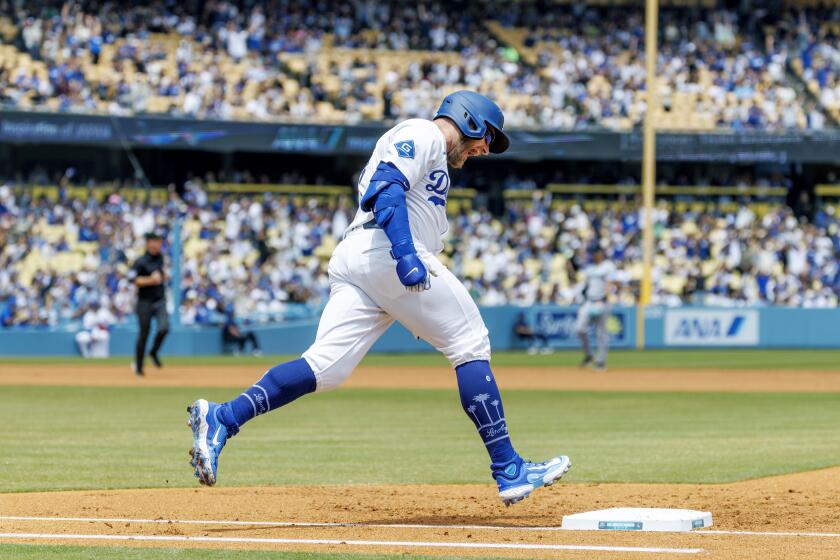Column: Dodgers need to take their time with Julio Urias
- Share via
As the Dodgers were absorbing the news last week that closer Kenley Jansen would be sidelined indefinitely with a heart problem, a potential bullpen reinforcement scaled the mound at a minor league stadium in Rancho Cucamonga.
Julio Urias pitched here for the first time four years ago, as a 17-year-old prodigy on the fast track to the major leagues. The left-hander was now only a couple of days from turning 22, hopeful of recapturing the magic that once made him one of baseball’s most prized prospects before major shoulder surgery.
The 4,000-plus fans in the building welcomed him, and Urias let the warm applause wash over him.
He was 14 months removed from tearing the anterior capsule of his pitching shoulder. This was only his third game back and his first in front of more than a handful of spectators at the Dodgers spring training complex in Arizona.
“The truth is that it made me very emotional to see so many people here cheering me on after I spent a year outside of competition,” Urias said in Spanish.
Urias pitched 1 2/3 innings for the Dodgers’ Class A affiliate Friday. He threw 29 pitches; the majority of his fastballs clocked at 91-93 mph. He struck out two, one with a high 92-mph fastball and another with a devastating 82-mph changeup. He allowed three hits, including a solo home run in the second inning on a curveball that didn’t break.
“I felt very good,” he said. “I felt strong.”
He wondered aloud what his fastest pitch registered on the radar gun.
Ninety-four-point-six, he was told.
He nodded.
“OK,” he said. “OK.”
He used to touch 97 mph.
“Little by little, I’m getting there,” he said. “We’re hoping it gets back to where it used to be.”
The Dodgers have to listen carefully to what he is saying.
He’s getting there. He’s not there yet. There’s a difference.
The Dodgers and their fans shouldn’t be counting on him to be the savior of their troubled bullpen. The focus should remain on his future, which the franchise still believes is as a starter.
If Urias can help the Dodgers out of the bullpen as part of the program to rebuild his arm, wonderful. If he can’t, so be it. It’s not his responsibility to make up for Andrew Friedman’s and Farhan Zaidi’s failure to address the team’s obvious shortcomings in the bullpen at the July 31 non-waiver trade deadline.
However unstable their bullpen, however precarious their position in the standings, the Dodgers have to resist the temptation of his talent and protect him. He shouldn’t be recalled any earlier than Sept. 1, when their expanded rosters would allow his usage to be dictated by what’s best for him rather than what the team needs.
To their credit, the Dodgers appear to be committed to moving Urias at a measured pace, even though manager Dave Roberts said last week that Jansen’s absence might accelerate his return to the major leagues. The team’s plan calls for Urias to pitch three innings at some point this week with double-A Tulsa, which indicates that management is still looking to deploy him as a long reliever instead of a late-inning weapon who could be called on regularly.
It’s only right, and not only because Urias is a possible franchise cornerstone. After what happened last year, the team is obligated to do right by him.
As much as the front office insists that Urias hurt his shoulder on a single throw that could have happened anywhere at any time, the reality is that he was injured after a few years under an experimental pitching program designed to minimize the number of innings he pitched while ensuring he could be available for crucial portions of the major league season.
Take last season. Not wanting Urias to increase his workload to where he could jeopardize his health, the Dodgers knew he would have to miss a part of the season: the beginning, middle or end.
The preference was for him to skip, or pitch minimally, at the start. But the Dodgers refused to commit to the plan because their front office’s fetish for injury-prone pitchers made it necessary for them to protect the team against the possibility of multiple injuries in the rotation.
Urias was required to prepare over the preceding winter as if he would be part of the opening-day roster. The Dodgers slowed him down in spring training and sent him to triple-A for the start of the season. They called him up, only to send him down again when he struggled.
Soon after, his season was over.
Urias never blamed the Dodgers for what happened to his arm. He was nonetheless frightened. Shoulder injuries aren’t the career-enders they used to be, but there’s still no guarantee of returning from them.
“The truth that is at the beginning, I was scared,” he said. “Yes, I was a little scared, but I remained confident in God. I believed in God. That’s what helped me move ahead.”
Watching his teammates play on television while he was limited to shoulder-strengthening exercises, he felt frustrated and helpless. In mid-May, he started throwing off a mound again, but he remained concerned.
“The first three bullpens were a little rough,” Urias said. “I was getting tired. I had problems with my breaking pitches when I started to throw them. It wasn’t pain. It was more fatigue.”
His hopefulness has gradually transformed into confidence over the last several weeks, enough to where he is now thinking he can be the pitcher he was once projected to become. He was particularly upbeat about the game he pitched in Rancho Cucamonga, in which he threw 12 of his 19 fastballs for strikes.
He said he would be open to pitching out of the bullpen this season, even though he doesn’t have much experience as a reliever.
“As long as I stay healthy, I’ll perform whatever role they say,” he said. “I’m not in position to decide that. That’s for them to decide.”
It’s not surprising that he would say this. From the time he pitched his first major league spring training game at 17, Urias sounded like an adult.
Now it’s time for the Dodgers to play the part of the adults. They have to take care of him the way he’s been willing to take care of them.
Twitter: @dylanohernandez
More to Read
Are you a true-blue fan?
Get our Dodgers Dugout newsletter for insights, news and much more.
You may occasionally receive promotional content from the Los Angeles Times.










